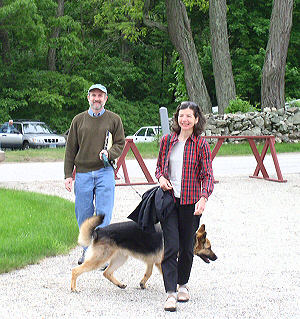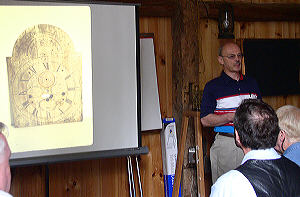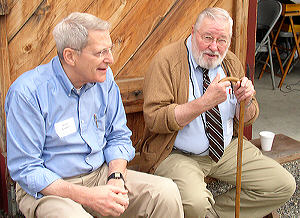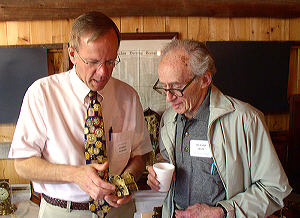New England Chapter No. 8 NAWCC11thANNUAL WILLARD HOUSE WORKSHOP
|
 Past Pres. Robert Frishman and wife Jeanne arriving with Becker just before the rains. |
An Outstanding WorkshopHighlights by Dick TreppOur 11th annual Willard Workshop at the Willard House in Grafton drew a standing room only crowd of 80 on June 7th. This is an all day affair with three exceptionally gifted speakers who are experts in their field. The three speakers are members of Chapter 8 and are well known to many other NAWCC chapters and events. After the presentations, the Willard House is open for tours to view the rare collections. Burt Kassap, our program chairman, worked hard to ensure a memorable day, and that all aspects of the event were covered. He was successful in all but one of his goals (to enjoy the beautiful outdoor setting) - it rained the entire day! |
 |
 |
||
|
|
Tom, not only has an outstanding collection of his own, but he has been the president of the American Clock and Watch Museum. He brought numerous examples of clocks to illustrate his talk. Rather than discuss all the numerous clockmakers in New England, he focused on the major players who made significant contributions to the clock making industry.
Tom pointed out, that prior to 1800, clocks were all hand made in this country. The first major development was also the start of the industrial revolution in the U.S. This was Ely Terry and his Porter contact for 4000 wooden works clocks, mass-produced for the first time for large clocks. Then came the Pillar and Scroll to make smaller cased clocks available. These models were successful from 1822 to 1845, along with the late 1820's introduction of the Jerome looking glass clock. The drive to reduce costs and increase profits in this industry was helped by Joseph Ives's developing a rolled brass. This 1830's event plus movements with a rack and snail, and the new bee hive case style were positive influences for increased sales. But in 1837 a major depression severely affected the entire country.
Again, ingenuity, in the form of a 30-hour inexpensive clock movement by Noble Jerome, came to the rescue and the clock industry started to revive. In the 40's came the balance wheel and the cast iron back plate. Steel springs began to replace brass ones. Wagon springs were another major development. And in the 1850-1860 period the Ithaca calendar clocks were introduced. In the ensuing years, other styles were introduced to make a thriving industry until the post WWII era.
 |
 |
||
|
|
"Accidents Waiting to Happen" or failure to diagnose the problems of mechanical clock movements, was the next topic by one of our clock repair experts, John Losch. With over 50 years of experience, he revealed to the audience what major things they should be doing before they initiate any repairs or restoration to a clock, their own or someone else's.
John discussed and handed out a printed detail of 26 problem areas to check. These only covered basic standard type movements, but they were sufficient to show how to conduct a thorough inspection. Pivots, wheels and arbors, mainsprings, plates, pallets, verges, pendulums, chime and strike levers, trains, and wooden movements were a few of the items. And within each topic, John discussed all the major points that frequently present problems. His emphasis was to check in a thorough and systematic way to make a professional and correct repair. John's talk, along with his good humor, brought many questions from the group. "Look before you leap" was really the sharing of fifty years experience with his audience.
Following the diagnosis of problems, some help in correcting the problems was given by Steve Sanborn, another talented clock restorer. He gave the audience a view of his ten favorite tools (and actually a few more), plus his comments on special materials and practices he uses. Steve also demonstrated special jigs and tool adaptations that he has made. From simple types of emery buffs, to pliers, to bushing tools, to the use of a crow's foot, to burnishing tools, were some of the items he covered. Steve also supplied the group with sources for purchase if they desired to do so.
And with Steve's easy and lighthearted look at repairs, he ended with a slide presentation of some the "horror" type repairs he has encountered in his shop. Whether the result of poor professional work or the ingenious idea of an untrained clock tinkerer, the slides were great examples of what not to do. Steve has seen it all or at least most of it!
-- Dick Trepp
* * *
Willard House & Clock Museum, 11 Willard St., North Grafton, MA 01536, 508-839-3500
See web site for directions.
8:30 A.M. Registration and morning refreshments
9:00 A.M. Presentation by Tom Grimshaw.
10:30 A.M. Coffee break and snacks
10:45 A.M. Presentation by John Losch
12:15 P.M. Catered box lunch
1:00 P.M. Presentation by Steve Sanborn
2:30 P.M. Informal visit to the museum
The Movements of Early American Clocks - History and Development
Tom Grimshaw
Diagnosing Problems of Mechanical Clock Movements (accidents waiting to happen)
John Losch, FNAWCC
Repair and Adjustment to Wood and Brass Movements - Tools & materials
Steve Sanborn
Registration for 2002 Willard House Workshop
Registrations @ $35.00 each Total enclosed $______
Name(s)________________________________________________
Street:__________________________________________________
City, State, Zip:___________________________________________
Phone:_______________________E-mail______________________
Mail by June 2 with check payable to "NAWCC Chapter 8" to Burt Kassap, 112 Bullough Park, Newtonville, MA 02460